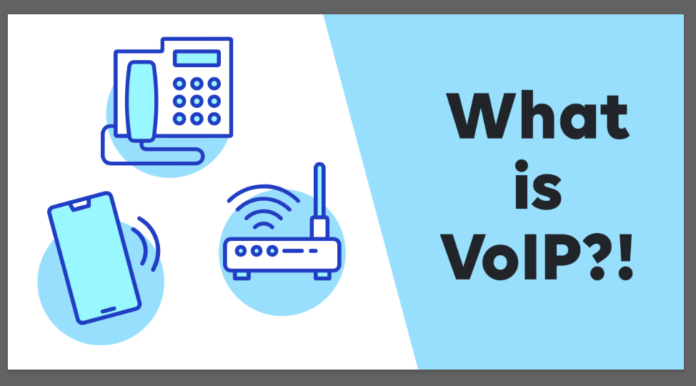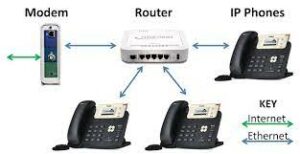
This article is a complete guide to VoIP. VoIP is gradually replacing conventional landline networks, making them obsolete. VoIP is currently the most efficient substitute for mobile phone conversation. The most noteworthy benefits of this cutting-edge communication technology for businesses are cost savings, premium audio quality, and sophisticated features. Today’s service providers provide a lot more choices than just voice calling. Process automation, Interactive Voice Response (IVR), contact routing techniques, video conferencing, and other features are available for clients to select from. Let’s explore VoIP in more detail to learn how it can benefit your business.
What is VoIP and How Does it Work Pros & Cons
In this article, you can know about What is VoIP and How Does it Work Pros & Cons here are the details below;
VoIP explanation
VoIP is a digital communication system that uses internet connections to transfer voice calls and data for business communications. In comparison to the copper-wired PSTN, it is the next best option. Also check Best Big Cartel Website Examples
Instead of using a traditional phone line, VoIP services enable business users to manage audio and video communications over the internet. VoIP, also known as internet telephony, enables you to interact with other subscribers of the same service by making audio/video calls over a broadband internet connection. VoIP services are perfect for making local, long-distance, international, and mobile calls using your existing desktop computer or specialized VoIP equipment. A VoIP adapter can be used to link the service to your phone as well.
What it does
VoIP transforms analog signals by converting speech calls into digital data that is transferred over either the public internet network or a private internet protocol (your IP address). (WiFi). Anywhere there is an internet link, you can use VoIP to make internet audio/video calls to mobile phones, landlines, and computer to computer. Other than voice calls, VoIP services allow file sharing, instant messaging, video conference calls, and other features.
What you need for a VoIP setup
A high-speed broadband internet link is necessary for a VoIP system to function. The following techniques will help you do this:
A cable connection, a local area network, and high-speed services like DSL.
This method also needs a computer, an adaptor, and a special phone device. The service supplier would determine the equipment range, though. While some VoIP service providers only function over a specialized device or computer, others let you link the system to your traditional phone using an adapter.
VoIP-capable phones are immediately connected to your internet connection. The following is a summary of crucial VoIP components:
- cloud-based or on-premises VoIP system;
- VoIP-enabled endpoints, such as VoIP devices, softphones, or analog phones with converters; and
- Better customer experiences are guaranteed by a steady internet link and faster connection speeds.
- Let’s now discuss the major features.
Key Features
VoIP can revolutionize your company’s interactions, but only if it has the best features, like:
- Advanced call management, which can be used to block, route, hold, or prioritize incoming calls to guarantee excellent customer support;
- call routing: route incoming calls in accordance with your requirements;
- Using an auto attendant, an automated receptionist can help your customer service and support representatives give each customer the utmost care;
- Business text messaging – keep your clients informed and keep your remote teams updated with unlimited SMS texting features;
- Call analytics – gather real-time customer insights to better your company, track behavioral patterns, gauge the effectiveness of your customer service team, etc.;
- Effectively manage customer calls during times of high call volume by using call forwarding;
- Queuing – reduce wait/hold times for high call volumes by automating inbound call distribution and establishing numerous call tiers;
- create a seamless customer-agent connection during call transfer;
- Instant messaging: Since the majority of contemporary consumers use messaging applications, instant messaging enables you to personalize your communications strategy and reach more potential customers;
- IVR – enables customers to contact your business via a live audio menu; and
- Video conferencing allows you to organize online meetings, link remote teams outside of the office, and enhance your marketing.
- All of these characteristics come with a number of advantages, but they also raise some potential problems. We will go over each benefit and drawback of these services in more detail below.
Pros
- Let’s start by going over the advantages of using VoIP services.
Cost-effective
No matter their size or business strategy, all businesses rely on their bottom line. Every alternative to cut costs creates a business chance. Investing in a VoIP phone system is a surefire method to enhance business communications while saving money.
VoIP services can cut your phone cost by more than 50% and are more affordable than landline phone systems. For long-distance calls, traditional phone service companies typically charge by the minute. On the other hand, VoIP service providers give limitless calling within the US, Canada, and the EU, as well as pay-as-you-go international calling options. VoIP services may be a more affordable option for managing your business communications if your company frequently makes foreign calls. You’ll also spend less on security, maintenance, monitoring, and upgrading because VoIP operates in a cloud setting.
Advanced features
Powerful, AI-enabled features are available from today’s VoIP service providers to assist business users in streamlining communications, enhancing customer experience, raising the caliber of customer support, and more. Advanced VoIP features can include call forwarding, web conferencing, AI virtual assistants, IVR menus, and real-time analytics monitoring in addition to optimizing business communication strategies.
These functions are essential for streamlining workflows, enhancing customer satisfaction, conserving time and resources for your team, and ensuring company development. An excellent illustration of an advanced VoIP function is live call sentiment analysis. It uses AI tools like voice recognition and natural language processing to track, monitor, and scan all incoming and outgoing phone calls for words and phrases that signify shifts in consumer behavior.
Live call sentiment analysis can track neutral, unfavorable, and favorable customer sentiments and generate review reports for managers to help them gauge contact volumes, agent productivity, and customer satisfaction. These priceless insights are essential for improving company communication procedures and making sure that customer support services are more efficient.
Flexibility and portability
In order to work effectively with highly mobile, hybrid, or remote business teams, flexibility and portability are necessary. VoIP can guarantee access to company phone systems regardless of location because it operates through an internet connection.
Without spending extra money on additional mobile or desktop infrastructure, you can simply connect your teams wherever they are and get around different time zones. VoIPs allow for immediate 24/7 access to features, corporate files, contacts, conversations, and more through softphone interfaces, web browsers, and Android/iOS apps.
Additionally, the best VoIP service companies offer adaptable team collaboration settings with whiteboard, file sharing, instant messaging, and video chatting features for fluid ideation. You can scale up or down your communications in accordance with your phone traffic requirements thanks to this flexibility and portability.
Better call quality
VoIP conversation quality has improved significantly over the past ten years. To help business customers improve call quality, modern service providers now provide automatic bandwidth adjustments, one-tier carrier partnerships, worldwide location coverage, and HD voice features.
Businesses can now guarantee 99.99% SLA-guaranteed uptime and top-notch communication quality during each customer contact. On-the-go issues like bandwidth overuse, heavy traffic levels, latency, jitter, and damaged audio can also be mitigated by businesses.
International coverage
Due to the mobility and portability of VoIPs, company users can increase their customer base internationally. Outside of corporate offices, businesses can connect remote teams and offer 24/7 client assistance and service. Modern service providers also provide multilingual assistance to guarantee efficient and streamlined communication despite any potential language barriers.
No technical setup required
VoIP service providers take the place of the need to spend money on extra technical setup infrastructure. Both speech and data are transmitted over the same channel. You don’t need any extra technology to set up your VoIP, even though some providers sell VoIP hardware like speakers, IP desk phones, and headsets.
Cons
VoIP systems do have some drawbacks. Listed below are some of the largest drawbacks.
Security issues
Every computer on your network that has internet access poses a security risk. Every internet-connected device is at risk from cybersecurity risks because hackers are constantly attempting to attack your devices with ransomware, malware, viruses, and other threats in order to steal important data. Regrettably, hackers can use your VoIP as an entry point and target your data in a cyberattack. However, you can set up security measures and implement antivirus software to give your company full-level protection.
VoIP depends on bandwidth
VoIP needs a steady, quick, and dependable internet link to function. For audio conversations, video conferencing, and other VoIP-related activities, you also need a premium router with at least 5–25 Mbps of bandwidth. Many ISPs have a tendency to throttle your link and reduce your bandwidth.
You still have access to a wide range of internet service providers, though, who charge moderate rates for ultra-fast broadband connection speeds. To prevent VoIP connection issues like jitter and latency, we advise paying more.
Low bandwidth might make customer assistance take longer and lead to new issues that might cost you customers. Although the amount of phone traffic will determine your bandwidth requirements, you can determine this by fully testing your network’s bandwidth to find potential improvement areas.
There are many causes of jitter, latency, and other network issues:
- VoIP needs more bandwidth than regular web browsing, which is a problem with slow internet connections. It strength be time to think about switching ISPs if you’re having latency.
- VoIP services can’t function properly with an insufficient router because they need specific router configurations. To support high phone traffic volumes, VoIP-configured routers favor voice traffic over data.
- Insufficient cables – You need enough cables to support faster connection rates because ethernet cords come in a variety of power levels and categories.
- These are just a few of the largest bandwidth problems, but there is also the problem of location tracking.
Limited location tracking
The largest drawback of VoIP is the limited location tracking. Due to VoIP’s portability and accessibility, it may be challenging for outside parties to determine the location of a conversation. VoIP calls originate from IP addresses, so they don’t contain GPS or cell tower information that could be used for monitoring.
While the majority of callers don’t need this information, customer support services may need it for a variety of purposes, including responding to emergency questions and resolving pressing client problems.
Conclusion
It is clear from comparing the positives and negatives of VoIP that the former surpass the latter. Also noteworthy are how quickly VoIP services can replace conventional phone systems and how simple the implementation process is. To handle all telephony requirements under one roof, business groups can set up unified communication portals.
While ensuring that your clients, customers, partners, and other prospects get the attention they merit, this communication unification enables your teams to concentrate on other important business aspects. The best way to end disruption and client dissatisfaction is with a VoIP phone system.












